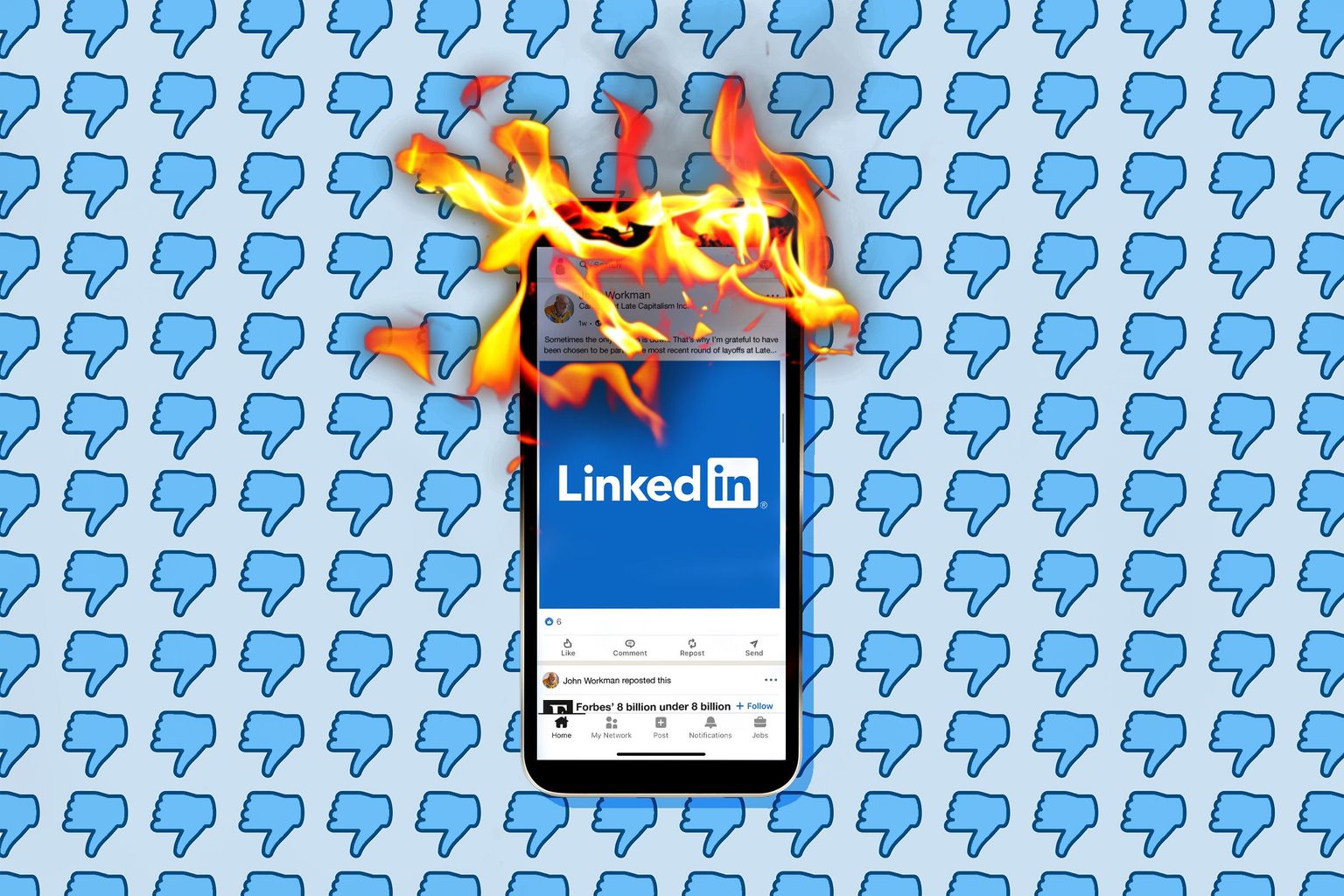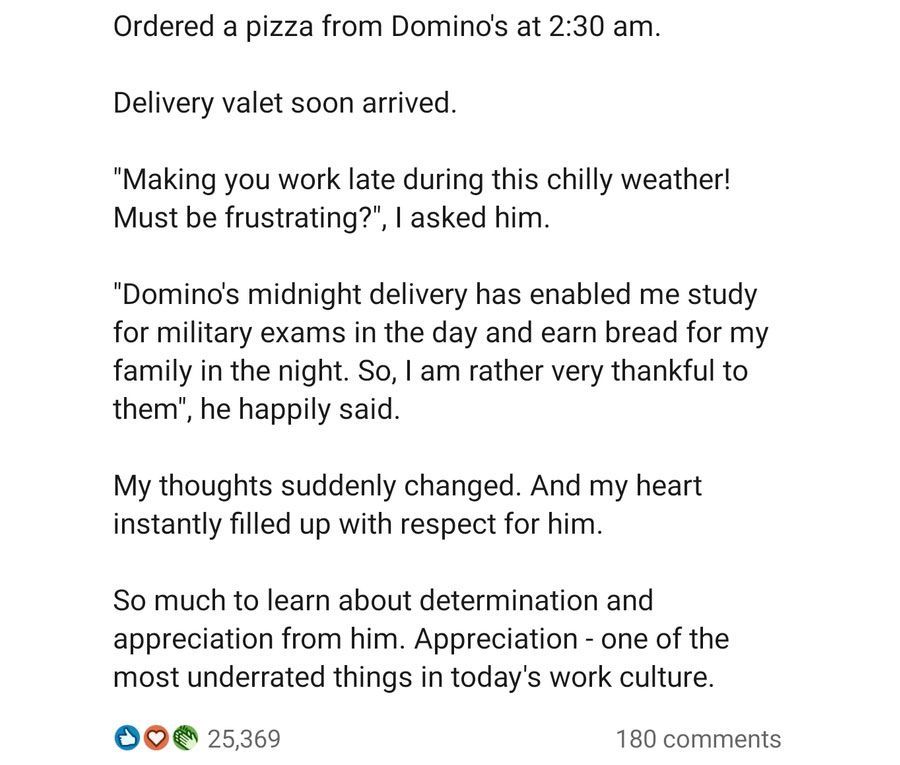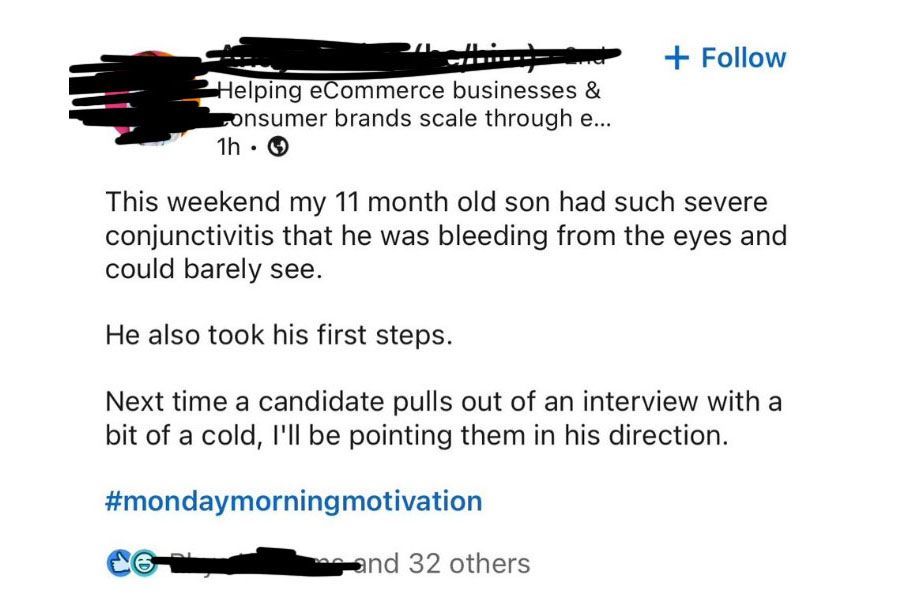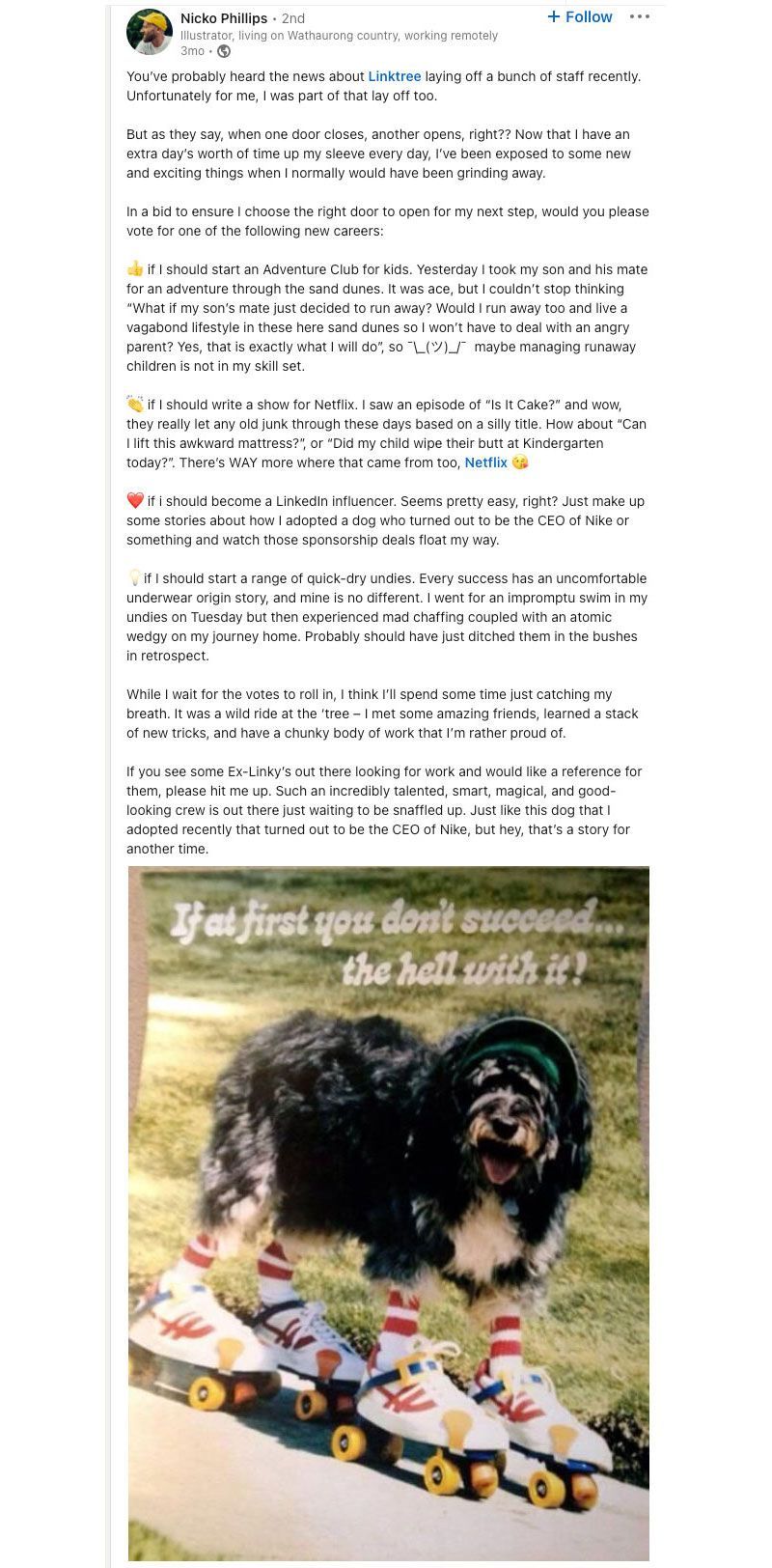So you’ve been fired. Here’s how not to post about it on LinkedIn.
Can you post about being laid off without seeming like an unhinged automaton? Comedian Patrick Marlborough investigates the strange, relentlessly happy phenomenon of being fired in the age of LinkedIn.

Photo illustration by Emily Thiang/Shutterstock.
LinkedIn has always been a mystery to me. Maybe it's my perpetual underemployment, my indifference to networking, or my inability to sit in a meeting for more than seven minutes without feeling like I am slowly turning into Travis Bickle—it will forever be a website that I don’t understand, populated by people I don’t want to. I think a job agency made me create a LinkedIn profile in 2016, but as a freelance writer and comedian generally hired to burn bridges, it’s always felt about as useful to me as—I don’t know—the metaverse will be to society at large.
Still, I do occasionally log on. And when I do, I feel like a 19th-century explorer adrift on a raft in the Amazon. Or maybe more like an Amazonian tribesman standing in Trafalgar Square. Point is, I’m filled with awe and horror at the same time, and terrified that the place will disappear me in a jungle of parasocial eye contact and digital handshakes. LinkedIn is a vibe and an energy that I will never truly grok, and I’m at peace with that.
And yet I can’t help but be drawn in by the rituals of this cult of online capital, marked as they are by compulsive glad-handing and a tendency to wax lyrical about the wonders of work in the form of apocryphal parables that would make Chaucer blush. Take, for instance, The Fable of the Domino’s Pizza Man:

Or this infection of #MondayMorningMotivation, which literally made my eyes water:

Or this act of courageous vulnerability, which was so egregious that even the usual LinkedIn brigade felt compelled to admit that taking a photo of yourself crying while laying off your employees was not a very boss move.
My LinkedIn newsfeed goes on and on like this in the tone and style of a hooded necromancer sitting in the corner of a crowded tavern, their face lit by candlelight, their hand suddenly pulling you towards their ghastly visage to ask if you’ve got enough #MondayMotivation to quest through the Nashkel Mines to retrieve their Amulet of Quarterly Reports.
It’s a murky, unpleasant realm. But perhaps murkiest and unpleasantest of all are the parts of LinkedIn that house what I’ve taken to calling the Positive Layoff Post, or PLP. The objective of these posts is to tell a story to the world about how you have been fired and are looking for work. But because the particular dialect of English used on LinkedIn has been scrubbed of anything approaching negativity, these posts are written in a tone that suggests that the face of Christ himself had appeared in the recently fired person’s Aeron chair to tell them that they are in fact the second coming, that only by dying can one be reborn, that only by being fired can one truly be promoted.
“This new opportunity is just what I need to hone my leadership skills and diversify my career experience whilst prioritising better family outcomes,” is how your standard PLP might begin, succinctly obfuscating the fact of their unemployment while channelling the tone of a person typing from the Waco siege. “Remember friends: chaos is a ladder.”
When the platforms we use favour certain types of stories, it’s understandable we end up telling them ourselves.
While PLP storytelling isn't new—people have been posting their L's online since the days of dial-up—it is becoming more common, especially as the economy slows down and big tech firms lay off more of the kinds of people who use LinkedIn as their primary social media platform. Yet as odd as these posts may seem, they actually say less about the bile imbalance of the average LinkedIn user than they do about the problem of the platform itself. More than any other social media site, LinkedIn requires its users to flatten the broad spectrum of human emotions into something relentlessly aspirational. The glass is always half-full, if not overflowing, even if you can't remember the last time you tasted a drop of water.
That this makes LinkedIn an insufferable hub of ROI-obsessed hustle culture is, obviously, not news. But it feels like the phenomenon may no longer be confined to the internet. Increasingly, our digital tulpas are oozing out of the web and sitting among us, steering our lives and society and the world in general towards the cliff face of dead-eyed algorithmic optimism. LinkedIn creates perhaps the saddest versions of these goblinite doppelgangers, as it lacks, for all intents and purposes, the entertainment drive and agreed upon lie of a Twitter, Instagram, or TikTok—that we’re just here to have fun. No one on LinkedIn is there to have fun. They’re not even there to work. They’re there to grind in a safe space of mutual embarrassment.
All of this—the unabating positivity, the Protestant requirement to be productive even in your retrenchment—is a feature rather than a bug of a system that exploits the human need to narrativise our existences. Our lives are not a series of random events occurring without rhyme or reason; they are three-act stories told in real time over the course of a human lifespan. We routinely tell ourselves these kinds of stories about our personal lives. And here we are online, doing the same with our professional ones. The result is the world’s saddest puppet show performed at a philosophical gunpoint, the bastardisation of our true selves to better lubricate our passage down the gastrointestinal tract of late capitalism on our way to its one inevitable end.
When the platforms we use to communicate with one another favour certain types of stories, it’s understandable we end up telling them ourselves; no one ever got a job by posting about how it sucks to keep getting fired. But is it possible to play the game without showing your whole arse? I have seen people try. This post, which the editors of the magazine you are currently reading have asked me to include in this article, comes the closest I’ve seen to skewering the Positive Layoff Post while still advertising the fact that the poster has been laid off and needs work:

Does this post avoid all the problems of the asinine PLP? Probably not—while it mocks the tiring positivity associated with the format, it still does so in a tone that suggests being let go is less of a gut punch than a gentle tap on the shoulder. But perhaps this kind of emotional hedging is the best we can hope for. Because really, what other option does the average worker have when the economy demands we all become relentless grifters in the societal equivalent of an inter-office email chain? That question is unanswerable to me, a wandering ronin who’s been known to spend months watching old episodes of Rove Live. All I can do is look on at the 800-word post of a fired creative director that is equal part self-promotion and self-flagellation and wonder at what point we agreed to live like this, and exactly who it benefits, before politely asking if anyone reading this knows of any work going. A guy’s got bills to pay.
